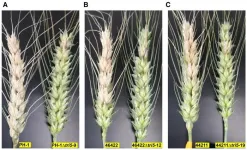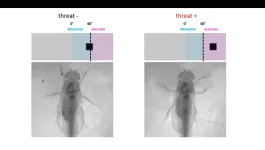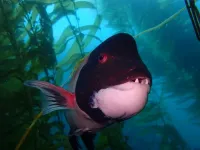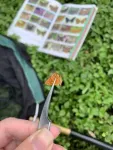(Press-News.org) Although wheat was among the first domesticated food crops, it remains a global dietary staple several millennia later. Grown on every continent except Antarctica, wheat is the second highest produced grain worldwide, with nearly 800,000 metric tons grown each year (Food and Agriculture Organization). However, a fungal pathogen named Fusarium graminearum causes the devastating disease Fusarium head blight (FHB) on wheat and contaminates grains with harmful toxins called trichothecenes. One such trichothecene, called deoxynivalenol (DON), is produced by most F. graminearum strains in the United States, and it is an essential virulence factor that increases the pathogen’s spread within a wheat head. This tiny yet powerful fungus threatens the economic security of millions of people and the food security/safety of billions more.
Currently, there are no known wheat (or barley) varieties that can completely resist Fusarium infection, prompting continual studies on FHB virulence factors. Recent studies have identified an F. graminearum population that produces a new trichothecene, called NX, with a slightly different chemical structure than DON. Dr. Guixia Hao and colleagues from the USDA-Agricultural Research Service investigated whether these NX trichothecenes contribute to FHB of wheat like DON. The results of their study, published in the journal Molecular Plant-Microbe Interactions (MPMI), reveal that NX trichothecenes play an important role in F. graminearum initial infection as well as FHB spread.
By deleting the first gene for trichothecene biosynthesis production, TRI5, from strains representing DON trichothecenes and NX trichothecenes, the researchers were able to assess FHB severity on susceptible wheat heads inoculated with these parent strains and the genetic mutants resulting from the deletion. Evaluation and further testing showed a higher amount of toxin produced by the NX-producing strain than the DON-producing strain. This reveals that deletion of one gene eliminates NX toxin production and decreases both fungal infection and disease spread in wheat, confirming that NX plays a similar role as DON in pathogen aggression and uniquely intensifies pathogen infection.
Commenting on the novelty of this finding, Dr. Hao says, “To the best of our knowledge, this is the first time that a mycotoxin (any toxic substance produced by a fungus) has been found to play a role in enhancing both pathogen infection and disease spread in wheat head."
This novel finding is especially exciting since it can be used to protect the quantity and quality of cereal grain crops. “The information we discovered provides a new way to potentially control infection (not merely reduce symptoms), FHB spread, and mycotoxin poisoning simultaneously by targeting the fungus’s ability to produce NX,” Dr. Hao explains, “And this study ultimately improves our understanding of how the fungus uses toxins as a new weapon to attack the plant.”
This knowledge can also inspire further studies on NX trichothecenes. Dr. Hao and colleagues are working on a follow-up study to generate transgenic plants that target the NX biosynthesis gene by ribonucleic acid interference (RNAi) to reduce disease and mycotoxin production.
To learn more, read NX Trichothecenes Are Required for Fusarium graminearum Infection of Wheat, published in Vol. 36, No. 5 / May 2023 of MPMI.
Follow the USDA-ARS on social media
Twitter @USDA_ARS
Facebook @AgriculturalResearchService
LinkedIn https://www.linkedin.com/company/usda-ars/
About Molecular Plant-Microbe Interactions (MPMI)
Molecular Plant-Microbe Interactions® is a gold open access journal that publishes fundamental and advanced applied research on the genetics, genomics, molecular biology, biochemistry, and biophysics of pathological, symbiotic, and associative interactions of microbes, insects, nematodes, or parasitic plants with plants.
Follow us on Twitter @MPMIjournal and visit https://apsjournals.apsnet.org/journal/mpmi to learn more.
END
New toxin facilitates disease infection and spread in wheat
2023-07-13
ELSE PRESS RELEASES FROM THIS DATE:
FAU receives $11.5 million gift to combat life-threating illness, amyloidosis
2023-07-13
Currently, there is no cure for amyloidosis, a life-threatening disease that can be present throughout the body, including the heart, kidneys, liver and brain. The most common localized form of amyloidosis, which is seen significantly more often, is in the brain. Cerebral amyloidosis, when symptomatic, usually manifests in one of two ways: in Alzheimer’s disease and related dementias and in brain bleeds, which have consequences such as a stroke.
Because amyloidosis does not affect a specific organ, unraveling the underlying cause of amyloid fibril creation – a hallmark ...
Schmidt Marine Technology Partners announces recipients of $3.5 million global sustainable fisheries initiative
2023-07-13
SAN FRANCISCO—Schmidt Marine Technology Partners, a program of the Schmidt Family Foundation, has awarded $3.5 million in grants to ten organizations and universities in seven countries for the development of new tools and innovations that will improve the sustainability of global fisheries, the program announced today.
“Tens of millions of jobs around the world depend on fisheries, and seafood is the primary protein source for 3 billion people,” said Wendy Schmidt, president and co-founder of the Schmidt Family Foundation. “The innovators chosen to receive these grants are ensuring that fishers and ...
New material could hold key to reducing energy consumption in computers and electronics
2023-07-13
A University of Minnesota Twin Cities team has, for the first time, synthesized a thin film of a unique topological semimetal material that has the potential to generate more computing power and memory storage while using significantly less energy. The researchers were also able to closely study the material, leading to some important findings about the physics behind its unique properties.
The study is published in Nature Communications, a peer-reviewed scientific journal that covers the natural sciences and engineering.
As evidenced by the United States’ recent CHIPS and Science Act, there is a growing need to increase semiconductor manufacturing ...
Artificially grown ‘mini-brains’ without animal components bring opportunities for neuroscience
2023-07-13
Researchers at University of Michigan developed a method to produce artificially grown miniature brains — called human brain organoids — free of animal cells that could greatly improve the way neurodegenerative conditions are studied and, eventually, treated.
Over the last decade of researching neurologic diseases, scientists have explored the use of human brain organoids as an alternative to mouse models. These self-assembled, 3D tissues derived from embryonic or pluripotent stem cells ...
Fear is in the eye of the beholder
2023-07-13
Averting our eyes from things that scare us may be due to a specific cluster of neurons in a visual region of the brain, according to new research at the University of Tokyo. Researchers found that in fruit fly brains, these neurons release a chemical called tachykinin which appears to control the fly’s movement to avoid facing a potential threat. Fruit fly brains can offer a useful analogy for larger mammals, so this research may help us better understand our own human reactions to scary situations and phobias. Next, the team want to find out how these ...
Multiple ecosystems in hot water after marine heatwave surges across the Pacific
2023-07-13
(Santa Barbara, Calif.) – Rising ocean temperatures are sweeping the seas, breaking records and creating problematic conditions for marine life. Unlike heatwaves on land, periods of abrupt ocean warming can surge for months or years. Around the world these ‘marine heatwaves’ have led to mass species mortality and displacement events, economic declines and habitat loss. New research reveals that even areas of the ocean protected from fishing are still vulnerable to these extreme events fueled by climate change.
A study published today in Global Change Biology, led by researchers at UC Santa ...
When the stars align: Astronomers find answers to mysterious action of ghost stars in our Galaxy
2023-07-13
A collaboration of scientists from The University of Manchester and the University of Hong Kong have found a source for the mysterious alignment of stars near the Galactic Centre.
The alignment of planetary nebulae was discovered ten years ago by a Manchester PhD student, Bryan Rees, but has remained unexplained.
New data obtained with the European Southern Observatory Very Large Telescope in Chile and the Hubble Space Telescope, published in Astrophysical Journal Letters, has confirmed the alignment but also found a particular ...
Skin lightening products can be dangerous, but users don’t know risks
2023-07-13
· Colorism – system of inequality that views lighter skin as more beautiful and advantageous – motivates skin lightening
· Users aren’t aware of adulterated ingredients in over-the-counter products such as mercury and steroids
· Products are purchased from chain grocery stores or online, used without medical advice
CHICAGO --- Skin lightening is prevalent in the U.S. among skin of color individuals – particularly women – but the people who use those products don’t know the risks, reports a new Northwestern ...
Small-winged and lighter colored butterflies likely to be at greatest threat from climate change
2023-07-13
PRESS RELEASE FROM THE UNIVERSITY OF CAMBRIDGE
EMBARGOED UNTIL 05:01 LONDON TIME (GMT) ON THURSDAY 13 JULY 2023
Images and paper available at: https://drive.google.com/drive/folders/18XRYP9dHcC1Z8lc3B86j3k6BzgIesqUS?usp=sharing
Small-winged and lighter coloured butterflies likely to be at greatest threat from climate change
The family, wing length and wing colour of tropical butterflies all influence their ability to withstand rising temperatures, say a team led by ecologists at the University of Cambridge. The researchers believe this could help identify species whose survival is under threat from climate change.
Butterflies with smaller or lighter coloured wings are likely to ...
Unexpected coupling with leaky mode unveils new path for dense photonic integration
2023-07-13
Defying conventional wisdom, researchers have uncovered a novel coupling mechanism involving leaky mode, previously has been considered unsuitable for high-density integration in photonic circuits. This unexpected finding opens new possibilities for dense photonic integration, revolutionizing the scalability and application of photonic chips in optical computing, quantum communication, light detection and ranging (LiDAR), optical metrology, and biochemical sensing.
In a recent Light Science & Application publication, Sangsik Kim, associate professor of electrical engineering ...








